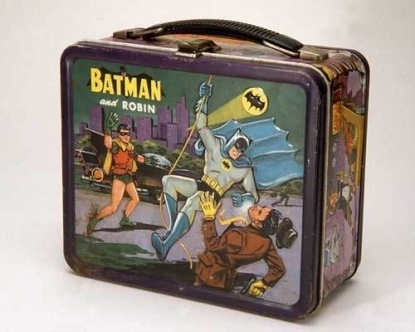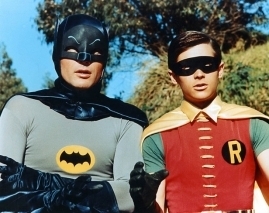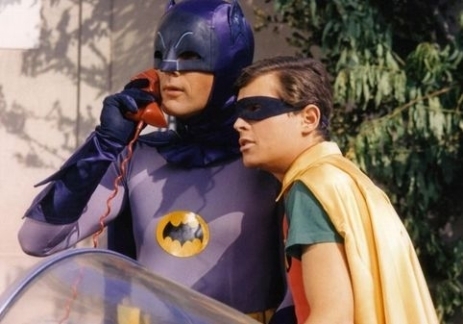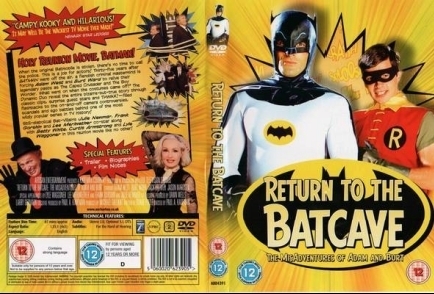Batman: Holy TV Series!
Far too many mainstream articles on comic book heroes begin with a smash-bang-boom smattering of onomatopoeia—“wham!”, “pow!”, “biff!”, and the like—but in the case of the Batman
television series from the 1960s, which famously displayed such words during fight scenes, it is entirely appropriate.
So, let’s let ’er rip: “Crash!” “Ooooff!” “Zok!” “Sploosh!” “Sock!” “Zap!” “Bam!” “Pop!”
Loved by some, reviled by others, the Batman
TV show polarized audiences from the get-go with its comedic, purposely corny take on Batman and Robin. Most younger super-hero fans loved the program, but to this day many diehard comic book fans consider it to be nothing short of blasphemous, placing their formerly dark, formerly muscular hero in preposterous situations and having him blurt out such goofy dialogue as “Catwoman has returned to besmirch the name of our fair metropolis” and “The Riddler contrives his plots like artichokes. You have to strip off spiny leaves to reach the heart.”
Baby boomer and pop culture expert Rick Kelsey, who remembers when the show originally aired in prime time, has little patience for the campy, tongue-in-cheek antics of the TV Batman.
“The ‘real’ Batman did NOT go around addressing people as ‘Citizen,’” Kelsey said. “Batman did NOT stop in pursuit of a criminal, wander over to a man getting out of his automobile, suggest to the man that he take the time to lock his car and hand him a bumper sticker encouraging people to lock their cars. The Batman in the comic books was nothing like that, but you could find the TV Batman doing stupid and idiotic things like that in every episode.”
Kelsey especially begrudges the negative influence the program had on super-heroes in general.
“I resent what the television series wrought,” he said. “In the wake of the TV show, Hollywood had an attitude of making fun of the source material when doing a movie version of a comic book or a cartoon show. It has finally changed for the most part as we can see by the recent and successful movie versions of comic book heroes like Spider-Man, Iron Man, Superman, and, thankfully, more faithful and realistic versions of Batman. But for the longest time, comic books were things to be made fun of by filmmakers.”
It’s true that the Batman
TV show poked fun at super-heroes. And it’s equally true that the campy program helped stigmatize the already-frowned-upon comic book medium as little more than juvenile junk food. (It wasn’t until Frank Miller’s The Dark Knight Returns
graphic novel in 1986 and Tim Burton’s Batman
film in 1989 that the Caped Crusader regained his dignity in the eyes of general public).
However, comic book fans who can view the show without regard for its source material (or at least without getting offended by its irreverence toward said source material) will find much to enjoy. The program is especially entertaining for those who took the show seriously as children, but now view it through nostalgia-glazed eyes as a titillating testament to the creative craziness of the psychedelic sixties (the brilliant color schemes and tilted camera angles of the villains’ lairs alone are worth the price of admission).
One such Batman
fan is writer/producer Ron Magid, who, in James Van Hise’s Batmania
(1989, Pioneer Books), referred to the show’s “high camp” and “ludicrous puns” as part of its charm. Further, Magid complimented the show on its “marvelously broad performances, superb sets, witty dialogue, brilliant camera work, and elaborate fight scenes.”
Produced by William Dozier, Batman
debuted as a mid-season replacement on ABC in 1966 and ran through 1968 (the show started off strong, but was eventually canceled due to low ratings), for a total of two and a half seasons and 120 episodes. Lorenzo Semple, Jr., who would go on to pen the feature films Flash Gordon
(1980) and Never Say Never Again
(1983), was lead writer. Another prominent Batman
scripter was Stanley Ralph Ross, who would later lend his TV-writing talents to The New Adventures of Wonder Woman
.
During most of its time on the air, two half-hour episodes of the Batman
program were shown per week, with a movie serial-style cliffhanger connecting the two installments. This format served the show well, helping create anticipatory excitement, especially among younger fans.
Adam West, appearing soft, unathletic, and unimposing in gray tights and small bat ears, played Batman, while Burt Ward masqueraded as the elfin, yet eager Robin. West delivered his lines smoothly, haltingly, and melodramatically, with an undercurrent of mock-earnestness that was a perfect fit for the campy dialogue. Ward complemented West nicely with his boyish enthusiasm, and with his infamously frequent, exclamatorily jubilant phrasing of “Holy insert inane word(s) here
Batman!”
They say a super-hero is only as good as his enemies, and Batman has a terrific rogue’s gallery. Many of Batman’s most famous adversaries made the transformation from the printed DC Comics page to the 1960s small screen, including: the Joker, played with relish by Caesar Romero; the Riddler, portrayed with maniacal acuity by Frank Gorshin; the Penguin, hammed up nicely by Burgess Meredith; and Catwoman, played by a super sexy Julie Newmar, who was purrrrfect for the part. (John Astin assumed the role of the Riddler once while Eartha Kitt took over as Catwoman in the third season).
During its relatively brief run, Batman
was seen as hip, postmodern, must-see TV by the Hollywood elite, prompting numerous celebrity guest appearances and cameos, including (but not limited to) Vincent Price (Egghead), Otto Preminger (Mr. Freeze), Art Carney (the Archer), Liberace (Chandell), Milton Berle (Louie the Lilac), Joan Collins (Siren), and Zsa Zsa Gabor (Minerva). In short, it was considered cool to watch Batman
and even cooler to be seen on Batman
.
One of the more noteworthy celebrity appearances on Batman
was the duo of Van Williams and Bruce Lee, who portrayed the Green Hornet and Kato (respectively) in the two-part story, “A Piece of the Action” and “Batman’s Satisfaction,” which revolved around a stamp counterfeiting ring. Williams and Lee were brought over from The Green Hornet
television series, which was also produced by William Dozier. Unlike Batman
, The Green Hornet
was played as a straight drama.
The star-studded Batman
TV series kicked off the first wave of “Batmania,” resulting in a barrage of Bat-merchandise, including coloring books, model kits, drinking glasses, board games, toothbrushes, lunch boxes, paperback books, records, bubblegum cards, toy vehicles, wrist radios, and much more. These items have, of course, gone up significantly in value since the time of their release, thanks in part to Batman’s continued popularity in comics (including “The New 52” version of the character), film (including The Dark Knight
trilogy), and television (including such cartoons as The Batman
, Batman: The Brave and the Bold
, and Beware the Batman
).
Some of the more collectable Batman items from the late 1960s include: a helicopter from Irwin Plastic Toy Inc. ($110); a Kohner push puppet ($250); a three-piece figure set from Ideal Toy Corp. ($150); a helmet and cape from Ideal ($250); a hand puppet from Ideal ($150); an Aladdin metal lunch box ($185); an Aurora Batmobile model ($85); and far too many other trinkets, doodads, and gewgaws to mention. (Prices are based on used items in good condition; mint-in-package versions often go for hundreds of dollars more.)

With the notable exception of books, magazines, and certain trading card releases, virtually none of the Batman products of the 1960s (or 1970s) featured photos of Adam West, Bruce Ward, or any other stars from the television series. Rather, generic comic book-style art was used to promote and decorate most of the items. However, when the second wave of Batmania swept the country with the release of Tim Burton’s Batman
film in 1989, it revitalized interest in the television program and tons of new collectibles were produced, many of which bore the actors’ images.
In addition to a second wave of merchandising, the late 1980s saw several Batman
TV show reunions, including one aired on the Fox Network’s The Late Show
(1988), which, at that point, was hosted by Ross Shafer (previous hosts include Joan Rivers, Buck Henry, and Arsenio Hall). Along with Adam West and Burt Ward, the Fox special featured Julie Newmar, Yvonne Craig (Batgirl), Alan Napier (Alfred the butler), Frank Gorshin, and Eartha Kitt, who regaled viewers in song with “I Want to be Evil.” George Barris, who designed the Batmobile, was also onboard, as were the original Batmobile and Batcycle.
In addition, West and Ward appeared as Batman and Robin in the made-for-TV Legends of the Superheroes
(1979), which is a live action Super Friends
/Justice League
farce comprised of two episodes: “The Challenge,” in which the heroes battle The Legion of Doom (including Frank Gorshin as The Riddler); and “The Roast,” which is a super-hero skewering hosted by Ed McMahon.
In the 2003, the irreverent (if tributary) Return to the Batcave: The Misadventures of Adam and Burt
was released on the small screen, reuniting West and Ward once again. The title characters, in addition to remembering their crime-fighting past, took off in search of the Batmobile, which—SPOILER ALERT—was stolen by Frank Gorshin and Julie Newmar.
These days, Adam West and Burt Ward tour the convention circuit, giving talks, meeting fans, signing autographs, and posing for photos. In November of 2010 at the Wizard World Austin Comic Con, West and Ward were honored by Austin mayor Lee Leffingwell, who made Batman and Robin honorary citizens of the popular (not to mention populous) Texas city, which is home to the largest urban bat colony in the world. (Fittingly, the 1966 Batman
feature film spun off from the show had its world premiere in Austin.)
For more info on the Batman
TV show, a handful of books on the subject have been published, including James Van Hise’s Batmania II
(1992, Movie Publisher Services) and Joel Eisner’s The Official Batman Book: The Revised Bat Edition
(2008, AuthorHouse).
Also recommended is Adam West’s autobiographical Back to the Batcave
(2002, Disc Us Books), which is a sincere (if amusing) account of West’s life and his role as Batman. Less interesting is Burt Ward’s Boy Wonder: My Life in Tights
(1995, Logical Figments Books), in which the author spends way too much time bragging about his sexual prowess.
Regrettably, thanks to various licensing and legal entanglements, the Batman
television series has yet to show up on DVD (though the 1966 film is readily available). Fortunately for Caped Crusader fans everywhere, the show does frequently turn up on cable television. Proponents of the program should also check out Batman—Holy Batmania
(2004), a DVD featuring four full-length documentaries on the show and more than 60 minutes of rare bonus materials.
Recently, Warner Bros. has authorized a host of new products based on the Batman TV show, including a clothing line and some strikingly realistic Mattel action figures.
If you decide to take in a few episodes of the Batman
television series, just be sure to have a sense of humor about the whole thing as this is definitely not the grim and gritty Dark Knight Detective from the comics or the recent films.
Or, as Robin might say, “Holy onomatopoeia, Batman!”
MY FONDEST BATMAN TV SHOW MEMORY: Having Adam West sign autographs at my comic book store, Fantastic Comics & Cards, in 1993. He was fun, friendly, and drew a big crowd.




